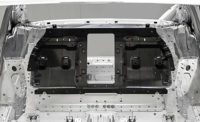Traditionally, it has been difficult to manufacture large quantities of carbon-fiber composites. That drawback has hindered widescale use of the lightweight material in the mainstream auto industry. However, engineers in Germany have developed a new process that makes it possible to use injection-molding technology.
Continuous fiber-reinforced composites with thermoplastic matrix resins are very well suited for use in automotive manufacturing. But, it has traditionally only been possible to use injection-molding for fiber-reinforced composites made of short fibers or long fibers.
“It has been very laborious to manufacture fiber-reinforced composites with a thermoplastic matrix in large quantities,” says Lars Fredrik Berg, project manager at the Fraunhofer Institute for Chemical Technology ( ICT). “On one hand, the textile-like dense continuous fiber-reinforced structures are difficult to shape. [And], joining the continuous fibers with a highly viscous thermoplastic matrix material is a highly complex process. To date, there is no economically profitable production technology for large-volume component series.”
However, Berg and his colleagues believe they have found a solution. Working in conjunction with engineers at the Technology Center for Lightweight Composites at Engel Austria GmbH, they recently created a prototype injection-molding machine.
“Continuous fiber-reinforced composite structures can be fed into the prototype machine and be impregnated with a very low viscosity plastics matrix,” claims Berg. “We have developed a process in which the in-situ polymerization of thermoplastic matrix materials works.
“We allow monomers, which are highly reactive molecules, to polymerize directly in the machine,” explains Berg. “The monomers have a shorter molecule chain than polymers, and therefore a lower viscosity.
“When being processed, the viscosity of the reactive plastics matrix is similar to that of water,” Berg points out. “This means that the fiber structures can be wetted down in an ideal manner, without displacing the structures in the form.”
The prototype injection-molding machine has already been used to make several types of auto parts, such as a brake pedal insert made out of fiberglass-reinforced polyamide.




